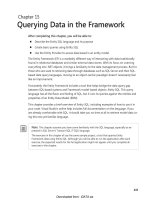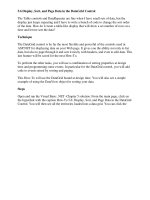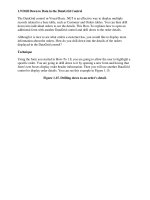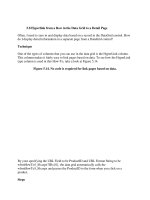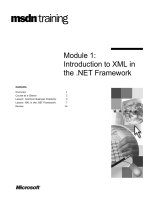Querying Data in the Framework
Bạn đang xem bản rút gọn của tài liệu. Xem và tải ngay bản đầy đủ của tài liệu tại đây (438.91 KB, 22 trang )
245
Chapter 15
Querying Data in the Framework
After completing this chapter, you will be able to:
Describe the Entity SQL language and its purpose
Create basic queries using Entity SQL
Use the Entity Provider to access data based in an entity model
The Entity Framework (EF) is a markedly different way of interacting with data traditionally
found in relational databases and similar external data stores. With its focus on coercing
everything into .NET objects, it brings a familiarity to the data management process. But for
those who are used to retrieving data through databases such as SQL Server and their SQL-
based data query languages, moving to an object-centric paradigm doesn’t necessarily feel
like an improvement.
Fortunately, the Entity Framework includes a tool that helps bridge the data query gap
between SQL-based systems and Framework model-based objects: Entity SQL. This query
language has all the flavor and feeling of SQL, but it runs its queries against the entities and
properties of an Entity Data Model (EDM).
This chapter provides a brief overview of Entity SQL, including examples of how to use it in
your code. Visual Studio’s online help includes full documentation on the language. If you
are already comfortable with SQL, it should take you no time at all to retrieve model data us-
ing this new yet familiar language.
Note
This chapter assumes you have some familiarity with the SQL language, especially as ex-
pressed in SQL Server’s Transact-SQL (T-SQL) language.
The exercises in this chapter all use the same sample project, a tool that queries Entity
Framework data using Entity SQL. Although you will be able to run the application after each
exercise, the expected results for the full application might not appear until you complete all
exercises in the chapter.
Dwonloaded from: iDATA.ws
246
Microsoft ADO.NET 4 Step by Step
Getting to Know Entity SQL
Entity SQL is based in part on the T-SQL imperative query language found in Microsoft’s SQL
Server product. Despite this lineage, there are some significant differences between T-SQL
and Entity SQL:
Entity SQL is a selection-only language. Whereas T-SQL includes support for data
manipulation language (DML) and data definition language (DDL), Entity SQL supports
only data retrieval. The focus is on the SELECT statement; INSERT, UPDATE, and DELETE
are not available. When updates are needed, the standard Entity Framework tools take
over.
None of the batch query or stored procedure functionality found in T-SQL is
available in Entity SQL. Entity SQL does include support for custom functions, but
they exist only to augment a related SELECT statement.
T-SQL focuses on the logical tables and rows in the database. Even when an
Entity Framework model targets a SQL Server database, Entity SQL queries focus on the
data as expressed through the conceptual model.
Writing Basic Queries
Entity SQL selection queries follow the same general syntax as those of standard SQL: with
SELECT, FROM, WHERE, GROUP BY, and ORDER BY clauses.
SELECT list-of-fields
FROM one-or-more-tables
WHERE Boolean-expression
GROUP BY aggregate-grouping-fields
ORDER BY sort-by-fields
As with standard SQL, all fields included anywhere within the query must tie back to a table
or entity that is specified in the FROM clause or in a subquery. The FROM clause usually lists
its sources from the available entities in the model—that is, to the entity collections that
themselves contain individual entities. These entity collections commonly use pluralized
names.
-- This is probably not correct
SELECT ... FROM Customer
-- But this is valid with its pluralized name
SELECT ... FROM Customers
Dwonloaded from: iDATA.ws
Chapter 15 Querying Data in the Framework
247
The SELECT clause is a comma-delimited list of the values to be returned in each result row.
In Entity SQL, every reference to a field value or property must include its associated en-
tity name or an alias to that name. In T-SQL, you can create a simple query without such
references.
SELECT ID, FullName FROM Customers
In Entity SQL, table references are required.
SELECT Customers.ID, Customers.FullName FROM Customers
It is more common to use table aliases.
SELECT c.ID, c.FullName FROM Customers AS c
Entity SQL does not support the * symbol used in SQL to specify all columns in a table. To
return the entire content of each matching row, use the table alias by itself in the SELECT
clause, or list the columns and properties individually.
SELECT c FROM Customers AS c
In this statement, the values returned are instances of Customer, which is the entity from the
application’s data model. Each data value returned from an Entity SQL query is, naturally,
expressed through a .NET object instance of some primitive or custom type. When relevant,
a query will return instances of an entity type or custom type from the model. If your SELECT
clause doesn’t correlate to a modeled data type, the query engine will return the data as a
collection of an anonymous type, a sort of impromptu nameless class that contains properties
that match the fields in the SELECT list.
To include more than a single entity in the FROM clause, use the JOIN keyword.
SELECT c.FullName, o.OrderDate, o.Total
FROM Customers AS c
JOIN OrderEntry AS o ON c.ID = o.Customer
Dwonloaded from: iDATA.ws
248
Microsoft ADO.NET 4 Step by Step
JOIN is a shortcut for INNER JOIN, which is the default type of inter-entity join. Entity SQL
also supports outer joins (LEFT OUTER JOIN, RIGHT OUTER JOIN, and FULL OUTER JOIN) and
cross joins (CROSS JOIN). The FROM clause also supports “applies,” which was introduced
in SQL Server 2005 (CROSS APPLY and OUTER APPLY) and can be used with dependent or
correlated entities. In all cases, the ON keyword specifies the fields on which to establish the
join.
The ORDER BY clause allows for a comma-delimited list of the fields by which the results
should be sorted, from left to right. The ASC and DESC modifiers from SQL are available in
Entity SQL.
SELECT c.ID, c.FullName
FROM Customers AS c
ORDER BY c.FullName DESC
By default, the data returned from an Entity SQL query is in the form of a table of rows—ac-
tually, a collection of object instances that all use the same named or anonymous type. This
is true even when the SELECT clause includes only a single value and the query returns only a
single row.
-- This single-row, single-column query still returns a row.
SELECT c.FullName FROM Customers AS c WHERE c.ID = 1
You can force the query to return the result (in each returned record) as a distinct value in-
stead of as a row containing one distinct value. To accomplish this, use the VALUE keyword
before the field specification.
-- This query returns a value, not a row of values.
SELECT VALUE c.FullName FROM Customers AS c WHERE c.ID = 1
Dwonloaded from: iDATA.ws
Chapter 15 Querying Data in the Framework
249
Using Literals, Operators, and Expressions
Entity SQL includes a wide variety of literal types that can be included in your queries.
Table 15-1 lists these literal types.
TABLE 15-1
Literals Available in Entity SQL
Literal Type Triggering Action
Integer By default, integer literals are 32-bit signed integers (Int32). You
can change the sign or size of the integer by appending literal
codes to the value: U for 32-bit unsigned literals (UInt32), L for
64-bit signed values (Int64), and UL for 64-bit unsigned numbers
(UInt64). For instance, the literal 123UL is a 64-bit unsigned value.
If you need to include other integer types in your results, the CAST
function lets you coerce a value into another data type:
SELECT CAST(123 AS System.Int16) AS ServiceCode, ...
Floating-point Value Any numeric literal that includes a decimal point is considered a
double-precision floating-point value (Double). To create a single-
precision floating-point value (Single), append the letter f to the
literal, as in 123.45f. Literals of type Decimal appear with a trailing
M, as in 123.45M.
String Strings can appear between either single or double quotes and are
non-Unicode by default. To treat a literal as a Unicode string, attach
an N to the start of the literal, as in N'abc'.
Boolean Entity SQL supports the true and false keywords for use as Boolean
values.
Date and Time All date values must include the time component; time values can
be used without an associated date portion. Dates (or dates with
times) use the DATETIME keyword followed by a specially format-
ted date and time in single quotes:
DATETIME 'YYYY-MM-DD hh:mm[:ss[.fffffff]]'
That is, a full year-month-day date followed by military-format
time with optional seconds, with or without a fractional seconds
portion.
Time values use the TIME keyword and omit the date portion:
TIME 'hh:mm[:ss[.fffffff]]'
The date-time-offset literal, a variation of DATETIME, includes
an offset of hours and minutes, plus or minus, from the specified
base date and time. This is useful for time zone offsets and other
purposes that require times and dates managed from a reference
clock:
DATETIMEOFFSET 'YYYY-MM-DD hh:mm[:ss[.fffffff]] {+|-}hh:mm'
Dwonloaded from: iDATA.ws
250
Microsoft ADO.NET 4 Step by Step
Literal Type Triggering Action
GUID To include a literal GUID, use the GUID keyword followed by the
dash-embedded GUID within single quotes:
GUID '28CA0BAE-27C9-446E-8DEB-C32E071C4B1A'
Binary Content Create binary content (for graphics and similar non-text data) us-
ing the BINARY keyword, followed by the hex-formatted binary
content in single quotes (attaching X to the start of the quoted
binary content also works):
BINARY 'A2AAE82303FF...'
-- or...
X'A2AAE82303FF...'
Null Value The keyword null represents a NULL value in any data type. Using
NULL values in some types of calculations always produces a NULL
result.
Entity SQL supports most of the common operators available in other SQL variants. The math
operators (+, -, *, /, and %, which represent addition, subtraction or negation, multiplication,
division, and modulo operations, respectively) work on either integer or floating point values.
The + operator also doubles as a string concatenation tool.
The comparison operators (=, <> or !=, <, >, <=, >=) can be used with numeric, string, date,
or other relevant data types, typically within the WHERE clause of a statement. The IN operator
matches one from a parenthesized set of options or subquery results. Similarly, the EXISTS
keyword returns true if a subquery includes any valid results.
The logical operators AND, OR, and NOT combine different logical expressions, and can be
replaced with the C-like synonyms &&, ||, and !, respectively. The special IS and IS NOT opera-
tors enable comparisons with the null literal.
As in SQL, simple field references can be replaced with expressions that include or exclude
any specific field. Parentheses can be included for grouping within complex expressions. The
following statement includes an expression in the SELECT clause, as well as both logical and
comparison operators in the WHERE clause:
-- Get the post-tax total for each unshipped, chargeable order.
SELECT o.OrderID, o.SubTotal * o.TaxRate AS OrderTotal
FROM AllOrders AS o
WHERE o.ShipDate IS NULL AND o.SubTotal > 0
As shown in the preceding code block, comment lines begin with two hyphens.
In addition to operator-induced data manipulation, Entity SQL includes several canonical
functions that accept expressions and properties as arguments and return a calculated result.
Dwonloaded from: iDATA.ws
Chapter 15 Querying Data in the Framework
251
Math functions Abs returns the absolute value of its integer or decimal argument.
The Power function raises a base to an exponent. The three functions Ceiling, Floor, and
Round truncate and round decimal values.
String functions The available string functions are closely tied with those used for
.NET strings. Concat joins two strings together just like the + operator. LTrim, RTrim, and
Trim remove excess whitespace. Left, Right, and Substring return a portion of a string
with an identified location and length. ToLower and ToUpper return a new case-altered
string. StartsWith, EndsWith, and Contains are Boolean functions that return true if a
partial string match is found. IndexOf is similar to those three functions, but returns a
numeric position for the match. Length returns the character length of a string. Replace
and Reverse both return new strings after applying the relevant changes to the content.
Date and time functions Entity SQL includes several Add... functions (such as
AddMinutes) that add (or subtract when negative) time value to a date/time base.
Similarly named Diff... functions (such as DiffYears) report the differences between
two source date/time arguments. Distinct Year, Month, Day, Hour, Minute, Second,
Millisecond, and DayOfYear functions return the specific component of a source date or
time. Truncate returns a date without its time portion. Other functions let you retrieve
the current date and time or build a new date and time from integer components.
Bitwise functions Instead of overloading the logical operators with bitwise function-
ality, Entity SQL includes distinct bitwise functions: BitWiseAnd, BitWiseNot, BitWiseOr,
and BitWiseXor.
Other functions The NewGuid function returns a newly generated and unique GUID
value. The CAST function lets you force a data value into another (allowed) type using
the syntax CAST(original-value AS new-data-type).
In addition to these built-in functions, Entity SQL includes a series of SQL Server-specific
functions. They are equivalent in functionality to their T-SQL counterparts, and they all begin
with the prefix “SqlServer.”
SELECT SqlServer.DATEPART("day", o.OrderDate) AS OrderDay
FROM OrderEntries AS o WHERE o.ID = 2932
The “SqlServer” component of this statement is actually a reference to a namespace named
“SqlServer.” Instead of attaching this prefix each time you need it in a query, you can also
apply the USING keyword to reference a namespace that you can then access throughout
the query.
USING SqlServer;
SELECT DATEPART("day", o.OrderDate) AS OrderDay
FROM OrderEntries AS o WHERE o.ID = 2932
Dwonloaded from: iDATA.ws
252
Microsoft ADO.NET 4 Step by Step
T-SQL’s CASE keyword, the inline conditional switch statement, is available in Entity SQL as
well. The CASE block can include any number of WHEN clauses and a single optional ELSE
clause to return conditional results.
SELECT CASE
WHEN o.OrderTotal > 0 THEN 'Standard Order'
WHEN o.OrderTotal < 0 THEN 'Refund'
ELSE 'No Charge'
END AS OrderType, ...
The UNION, INTERSECT, EXCEPT, and OVERLAPS keywords, as well as the SET function en-
able set operations on query results. UNION merges two result sets, whereas INTERSECT
returns only those rows that appear in both sets. EXCEPT returns the first set with any rows in
the second set removed. OVERLAPS returns true if any row appears in both sets being com-
pared. SET returns a subset that includes only unique rows.
Grouping and Aggregating Entity Data
Entity SQL includes several aggregate functions that allow your query to generate summa-
rized data across a range of included records. The following statement adds up all order
totals in the OrderEntry table:
SELECT SUM(o.Total) AS TotalOfAllOrders
FROM OrderEntry AS o
In addition to SUM, which totals up a column of numeric values, the language includes the
following aggregate functions:
COUNT and BIGCOUNT Counts the total number of records included in the query;
or when passed a column name or calculated expression, returns the number of non-
NULL results. Entity SQL does not support the COUNT(*) syntax typically used in other
SQL variants. Instead, use COUNT(0). BIGCOUNT is identical to COUNT, but returns a
64-bit integer instead of a 32-bit integer.
MAX and MIN These functions return the maximum or minimum value within the re-
sult set for the supplied column name or expression. Numbers, strings, dates, and other
data types that support ordering of items can be used as arguments.
AVG Returns the average for the supplied column or expression across all included
records. AVG supports numeric values only.
Dwonloaded from: iDATA.ws
